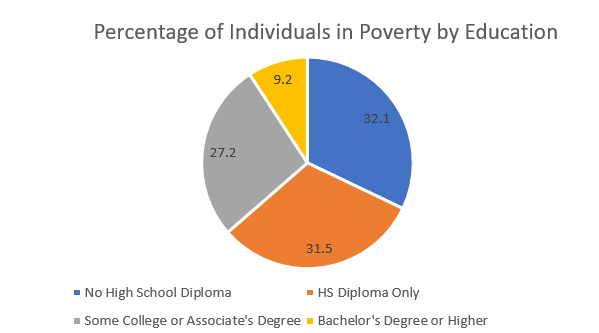Overview:
There is a tendency to assume that people who live in poverty are uneducated; that getting a good education will prevent someone from falling into poverty. Maps 11 through 14 explore this idea further by looking at individuals 25 years and older and their educational attainment. Clicking on a map will show it as a full length page.
As the maps show, going to college does not automatically save a person from becoming impoverished. It does appear, though, the more education one pursues, the less they are at risk. However, as you can see from Chart 1, the idea of a higher education equaling less risk is not as simple as it may seem.
Despite the maps suggesting that people with a higher education have a buffer against poverty, Chart 1 suggests otherwise. Within each sub-category of education, the higher one’s education the less likely they are to be impoverished. However, when you observe the overall percentages, this buffer only benefits people with at least a Bachelor’s Degree.
A possible reason for the difference between the maps and the graph could be the result of the number of individuals within each sub-category. The percentage of people in North Carolina with no high school diploma is 13.9%. Of those individuals, 15.9% lived in poverty. In comparison, the percentage of people with some college or an Associate’s Degree is 30.9%. Of those individuals, 11.8% lived in poverty. The point being, that looking at percentages within a sub-category alone, does not always show the bigger picture (i.e. the chart). The education buffer is not as strong as the maps would suggest. People who attend college are still vulnerable to falling into poverty.




